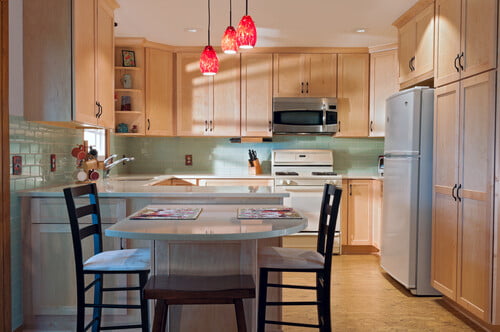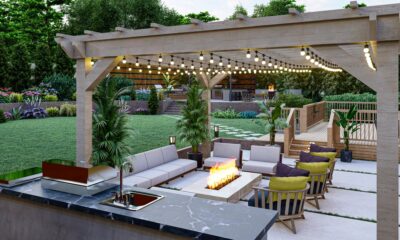

Sustainability
Sustainable Lighting Design Ideas For Your Kitchen
In 2006, Tree Hugger published a great article on environmental lighting ideas. That is still the best article in its class to this day. If you want to live a greener lifestyle, then using eco-friendly lights is the way to go.
Environmentally Friendly Lighting is Key to Sustainability
Green kitchen design is about three core elements. Layout, practicality and, of course, lighting. Yes, your kitchen should be lit just right, not too bright but not too dim either. Because your kitchen is the heart of your home, which means you need it to be at its best. So, whether you’re aiming to set the mood or prepare quality food, you need to understand how you should be lighting your kitchen, right?
Well, luckily for you, we’re here to provide you with kitchen lighting design tips, to help your home shine (literally). We’ve spoken to Roman Kitchens, expert kitchen designers in Essex, about how to light your home properly. With that in mind, let’s find out the kitchen lighting design tips they’ve suggested, right here.
There are a number of things that you need to do when choosing lights that are good for the environment. You need to look for lighting systems that:
- Don’t have too many LEDs
- Preferably have CFL bulbs (the energy savings pay for the cost of the bulb after 500 hours of use, while they last much longer)
- Come from recycled materials such as reclaimed lenses from traffic lights and glass beverage bottles
- Use the wallwarts
- Can partially power themselves with solar
There are a lot of ways that you can choose lights that greener.
Use Lighting Smartly
A key tip from all environmentally conscious kitchen designers is to only use light where it’s needed. Sure, having loads of light around your kitchen may seem like a good idea, but it’s not overly beneficial to the look and feel of your kitchen. You should divide your lighting into two sections: task and mood lighting. Task lighting should be logical and highlight areas where you need to prepare food and work. Whereas mood lighting is about creating a certain atmosphere. Balance your lighting cleverly between task and mood.
Work Around Furnishing
Whilst it’s a great idea to plan lighting at the beginning of the design process, nothing should ideally be installed before the plans are finalized, and all the furniture, fixtures and fittings are installed. Because, like we’ve said above, lighting needs to be logical, which means you need necessary lighting in your kitchen which is hard to achieve once it’s been installed. When you’re 100% happy with plans and layout, start work on your lighting.
Be Conscious
Whilst it’s good to have loads of lighting in your kitchen, the electricity consumption can be overwhelming for the planet and your wallet. So, use LED bulbs and strips in your kitchen. Not only do the consume less power but they last around 40,000 hours (compared to halogen lights lasting 3,000 hours). They’re not only better for the environment but even better for your household bills. Keep energy consumption and costs down, with LED lights.
Planning your lighting in your kitchen is no small task, which is why many choose to rely on their kitchen designer. Most kitchen designers, as part of their service, can recommend lighting solutions and help plan the lighting around your kitchen. If you’re worried about the lighting of your kitchen, consider using the professionals. Ask your kitchen designer about what they can do for you (lighting wise).
Divide Circuits
One thing that is a common mistake in kitchen lighting is having all of the lights on a single switch. These aren’t just more energy efficient. They are also good for you too!
Mood and ambience are affected by how many lights are on and how brightly they shine. If one switch turns on all your lights, then it’s not ideal as you can’t achieve the relaxed mood you may want. Which is why it’s important to make sure that your light switches are divided logically. Make sure to separate mood and task lighting on different switches, so you can control the feel of your home. Also, dimmer lights are a great way to set the mood. So, try and incorporate dimmer switches if possible.
Natural vs. Artificial
Finding the right balance between natural and artificial lighting is key when designing your new kitchen. Yes, in the darker winter months (with longer evenings) you’ll be using your artificial lights more, but the balance needs to be logical. Natural light opens up your home and makes it feel more spacious whilst artificial light is great for tasks and setting moods. Make sure you’re considering where your natural light sources are coming from. Whether it be through a select window, roof lantern or bi-folding doors, thinking about how natural and artificial light can work together is essential. Considering which way your kitchen faces will give you a good inkling as to how important natural light will be for your kitchen. North facing kitchens may poorly lit by natural light whilst South and West facing ones will be bright into afternoon – so, make sure you factor this in to your lighting plans.
Always Accent
Your new kitchen may include some interesting features, like an island unit, so how do you ensure the eye is drawn? Well, simple, with a third lighting section – accented lighting. Yes, accented lighting plays an integral role in highlighting elements of your kitchen. Dining tables, island units – these can both be accented with the right lighting. Pendant lights make a great accent light for dining tables and island units whilst LED strips can highlight features like display cabinets or a breakfast bar. Remember, if you’ve got it, flaunt it – with accent lighting.
Choose Environmentally Friendly Lighting Ideas
Being environmentally conscious isn’t easy. You need to think about a lot of ways that you are leaving a carbon footprint. Finding more energy efficient lights is a great start!
Potential title: Sustainable Lighting Design Ideas For Your Kitchen
Tagline: Want your kitchen design to be ecofriendly? Consider these sustainable lighting design ideas for your kitchen to make it both cozy and great for the earth.
































